Dodge Journey: Installation
2.4L
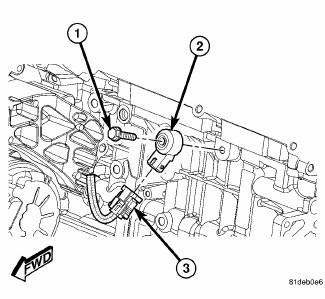
Fig. 52: 2.4L Knock Sensor
CAUTION: Always torque knock sensors to the correct torque specification. Over or under tightening effects knock sensor performance. Ensure the electrical connector orientation is at the sic O'clock position to the engine block.
1. Install knock sensor (2) and bolt (1) to engine block. Tighten bolt to 22 N.m (195 in. lbs.).
2. Connect electrical connector (3) to knock sensor (2).
3. Connect negative battery cable, tighten nut to 4.5 N.m (40 in. lbs.).
2.7L
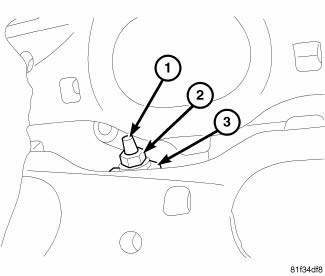
Fig. 53: Knock Sensor 2.7L
- - Stud
- - Nut
- - Knock Sensor
CAUTION: Over or under tightening effects knock sensor performance resulting in possible improper spark control.
1. Install knock sensor (3) and nut (2) onto stud (1).
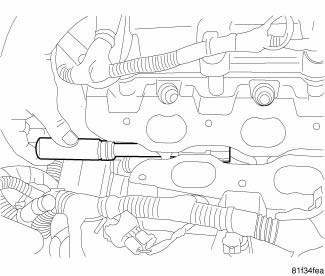
Fig. 54: Tighten Knock Sensor Nut
2. Tighten knock sensor nut to 15 N.m (11 ft. lbs.).
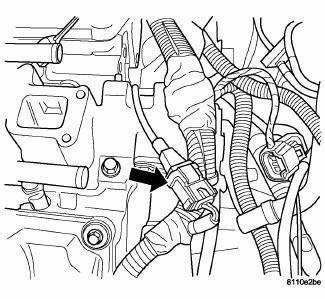
Fig. 55: Knock Sensor Connector
3. Attach electrical connector to knock sensor.
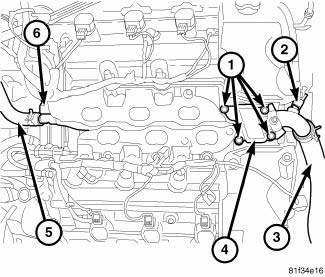
Fig. 56: Water Housing Outlet Tube 2.7L
- - Bolts
- - Coolant Temp Sensor Connector
- - Radiator Upper Hose
- - Water Housing Outlet Tube
- - Heater Hose
- - Retaining Clip
4. Position the water housing outlet tube (4) to the cylinder heads and loosely install four bolts (1).
5. Attach water housing outlet tube (4) to the retaining clip (6) at rear of engine.
6. Tighten the four bolts (1) to 3 N.m (30 in. lbs.).
7. Connect electrical connector (2) to the coolant temperature sensor.
8. Install heater hose (5) to water housing outlet tube (4) at rear of engine.
9. Install radiator upper hose (3) to water housing outlet tube (4).
10. Install intake manifold.
11. Connect negative battery cable, tighten nut to 5 N.m (45 in. lbs.).
12. Fill cooling system.
13. Operate engine until it reaches normal operating temperature. Check cooling system for correct fluid levels.
3.5L
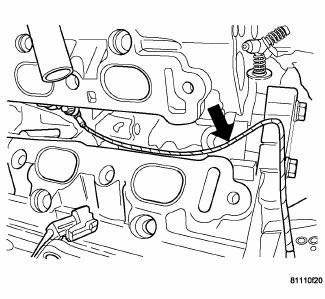
Fig. 57: Knock Sensor Wire Route
CAUTION: Always use the specified torque when installing the knock sensor bolt.
Over or under tightening the sensor mounting bolt will affect knock sensor performance, possibly causing improper spark control.
1. Install knock sensor. Tighten knock sensor to 20 N.m (15 ft. lbs.).
2. Route the knock sensor wire in the proper location.
3. Install upper intake manifold.

Fig. 58: Knock Sensor Connector
4. Connect the electrical connector.
5. Connect the negative battery cable.
 Removal
Removal
2.4L
Fig. 45: Locating Knock Sensor
The knock sensor bolts into the side of the cylinder block in front of the
starter under the intake manifold.
1. Disconnect and isolate negative battery ca ...
 Spark plug
Spark plug
...
See also:
Installation
Fig. 101: Check For Stretched Bolts
- STRETCHED BOLT
- THREADS ARE NOT STRAIGHT ON LINE
- THREADS ARE STRAIGHT ON LINE
- UNSTRETCHED BOLT
NOTE: The cylinder head bolts (4) are tighte ...
Diagnosis and Testing
BASE BRAKE SYSTEM
NOTE: There are three diagnosis charts following that cover the RED
BRAKE
WARNING INDICATOR LAMP, BRAKE NOISE and OTHER BRAKE CONDITIONS.
RED BRAKE WARNING INDICATOR LAMP ...
Installation
2.4L
Fig. 17: Removing/Installing Ignition Coil
1. Install ignition coil onto spark plug.
Fig. 18: Removing/Installing Ignition Coil Mounting Bolts
2. Install ignition coil mounting bolt, tigh ...
